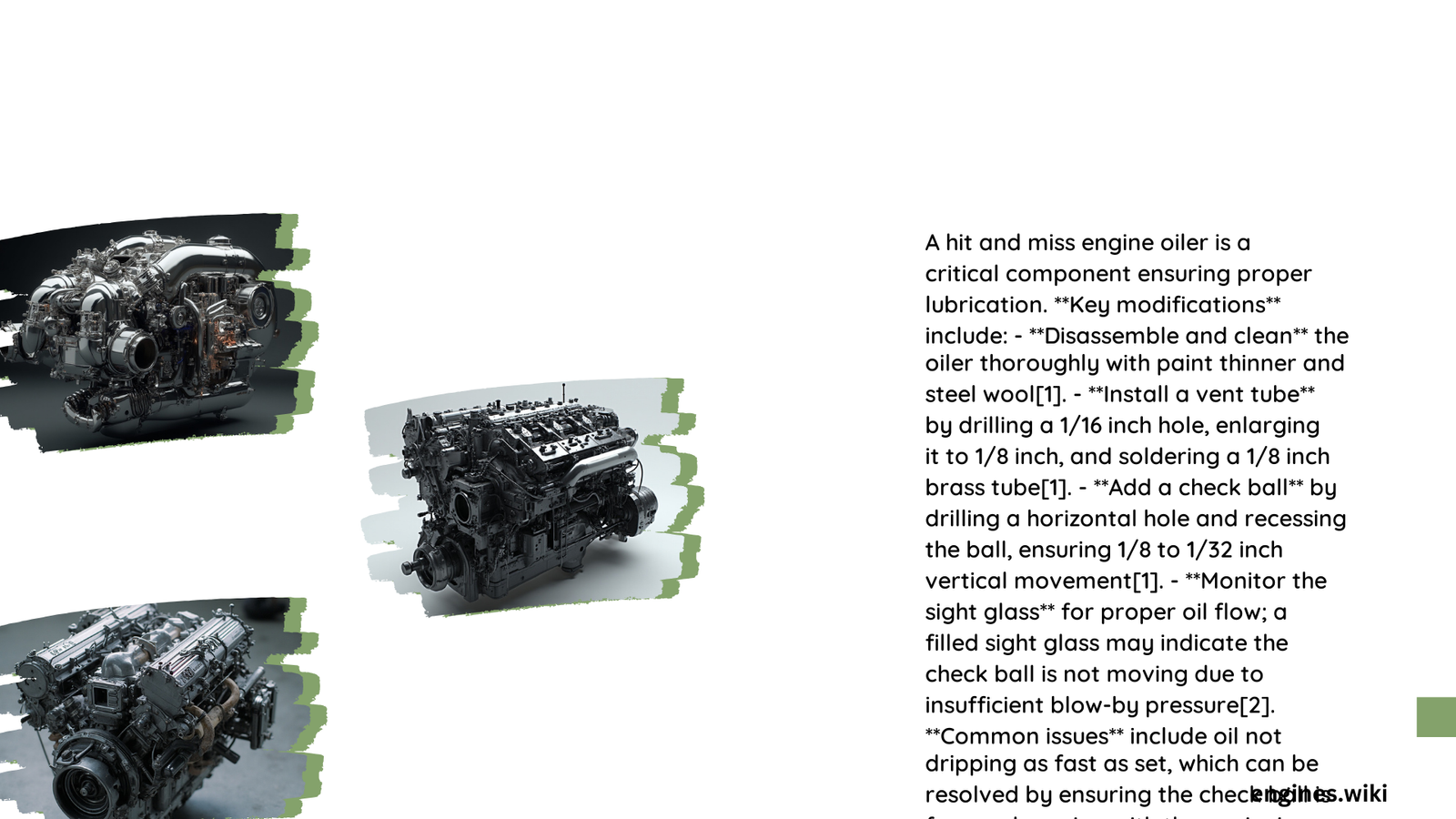Hit and miss engine oilers represent a critical component in preserving and operating vintage internal combustion engines, providing precise lubrication mechanisms that ensure smooth mechanical performance. These specialized oiling systems deliver targeted oil distribution across engine components, maintaining optimal functionality through gravity-fed or check valve mechanisms that prevent mechanical wear and enhance overall engine longevity.
What Makes Hit and Miss Engine Oilers Unique?
Hit and miss engine oilers are specialized lubrication systems designed specifically for vintage stationary engines, characterized by their distinctive oil delivery methods and mechanical precision. Unlike modern engine lubrication systems, these oilers rely on mechanical principles that require manual intervention and careful maintenance.
How Do Hit and Miss Engine Oilers Function?
Gravity-Based Oil Delivery Mechanism
- Reservoir Design: Typically constructed with transparent glass or metal containers
- Drip Rate Control: Manually adjustable oil flow mechanism
- Precision Lubrication: Delivers specific oil quantities based on engine requirements
| Oiler Type | Oil Capacity | Typical Application |
|---|---|---|
| Small Engine Oiler | 50-200 ml | Compact Stationary Engines |
| Medium Engine Oiler | 200-400 ml | Agricultural Machinery |
| Large Engine Oiler | 400-600 ml | Industrial Equipment |
What Are the Critical Components?
Essential Oiler Elements
- Oil Reservoir
- Stores lubricating oil
- Allows visual monitoring of oil levels
-
Constructed from durable materials
-
Drip Mechanism
- Controls precise oil distribution
- Prevents over-lubrication
- Ensures consistent mechanical performance
How to Select the Right Hit and Miss Engine Oiler?
Evaluation Criteria
- Engine Horsepower
- Operational Environment
- Mechanical Complexity
- Maintenance Requirements
What Maintenance Practices Ensure Optimal Performance?
Recommended Maintenance Protocols
- Daily Visual Inspection
- Check oil reservoir levels
- Examine drip mechanism functionality
- Weekly Cleaning
- Remove accumulated debris
- Verify unobstructed oil flow
- Monthly Comprehensive Review
- Inspect mechanical components
- Replace worn gaskets and seals
What Challenges Might Operators Encounter?
Common Troubleshooting Scenarios
- Inconsistent Oil Flow
- Potential causes: Clogged mechanisms
- Solutions: Thorough cleaning, mechanism adjustment
- Oil Leakage
- Potential causes: Worn seals, improper installation
- Solutions: Seal replacement, precise alignment
What Are Best Practices for Installation?
Step-by-Step Installation Guide
- Verify Compatibility
- Measure engine specifications
- Select appropriate oiler model
- Secure Mounting
- Use recommended hardware
- Ensure level positioning
- Connect Lubrication Lines
- Use appropriate tubing
- Verify secure connections
- Initial Calibration
- Adjust drip rate
- Monitor initial performance
Expert Recommendations
Successful hit and miss engine oiler operation requires patience, precision, and consistent maintenance. Operators should prioritize understanding their specific engine’s requirements and invest time in learning proper lubrication techniques.
Technical Specifications to Consider
- Oil Viscosity: Typically SAE 30 or manufacturer-recommended grades
- Drip Rate: 1-10 drops per minute, depending on engine size
- Reservoir Capacity: 50-600 ml, engine-dependent
Conclusion
Hit and miss engine oilers represent a fascinating intersection of mechanical engineering and historical preservation, requiring specialized knowledge and meticulous care.

